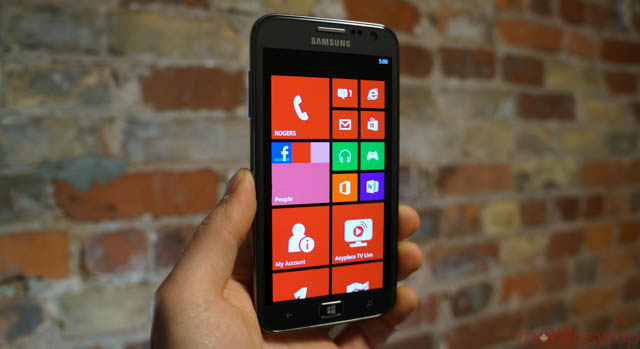

Samsung’s ATIV S was the first Windows Phone 8 device to be announced. Since then the hype for Microsoft’s overhauled mobile OS has subsided, but the battle rages on. Apps are beginning to be updated; users are starting to take notice. Despite impressive showings from Nokia and HTC, Samsung is a trusted name in smartphones today, and could be the very thing the ecosystem needs to thrive.
A clear descendent of the Samsung Galaxy S III, the ATIV S is more a Focus S successor than a direct crib of its Android counterpart. Nevertheless, it’s an attractive and surprisingly elegant handset, and stands to do quite well for the company. But can it draw attention away from the incumbent Lumia 920 and HTC 8X? And, most importantly, can the Samsung name do for Windows Phone what it’s been able to accomplish for Android? Let’s take a look.

Build and Screen
When the ATIV S was announced back in August, it was thought that Samsung was about to transition its long-criticized plastic melange to a hardier, and ultimately heavier, metal exterior. Alas, it didn’t work out that way, although Samsung made it appear so. The ATIV S maintains the chrome-like plastic heritage of the Galaxy S III and Note II, although the battery cover does look, at first glance, to be made of aluminum. That the phone has a removable cover, in addition to a replaceable battery, is a first among Windows Phone 8 handsets, though, as a result, the ATIV lacks the solidness of the Lumia or 8X.
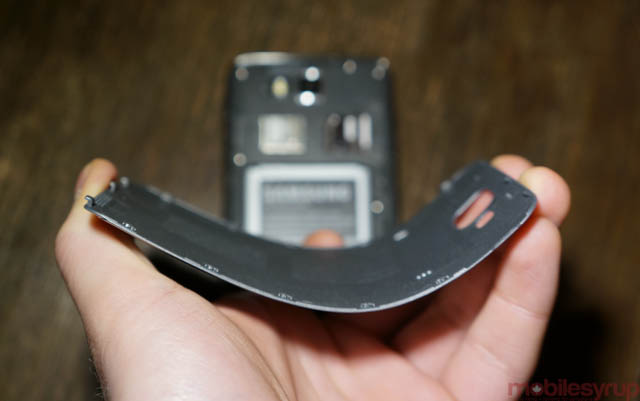
Samsung has done a lot of things right here, though. The phone feels welcome in the hand, and the tactile home button is preferable to the easily-brush capacitive areas of the Lumia 920. The screen is bright, well saturated and the largest available on a Windows Phone 8 phone, which is sure to please any Android converts. But, unlike six months ago, there is little remarkable about the HD Super AMOLED display; not only has its PenTile heritage been surpassed in clarity by the Note II, but the Super LCD 2 display on the Windows Phone 8X is preferable in every day use.
It’s hard not to think that Samsung, like it does with its Android line, pivoted on an axis here. The company typically only makes one radical design change per generation, and felt that its Galaxy S III template had not yet overstayed its welcome. But saying the ATIV S is the Lumia 920 to the Galaxy S III’s Lumia 900 misses the point entirely. The Lumia line is inherently unique; it is also objectively beautiful. The ATIV S feels like a fresh coat of paint on an aging sports car: it’s got a great engine, but at some point its design will fall out of style.

Performance and Software
The ATIV S doesn’t stray far from what we’ve already shown you on the Lumia 920 and Windows Phone 8X. If you’re partial to Windows Phone 8, you’ll love the big, welcoming red tiles on the Rogers version. But Samsung, unlike Nokia, seems satisfied providing a minimum in additional functionality.
The company has pre-installed a number of apps to get users started, including ports of Android’s ChatON, its multi-platform messaging service, and Music Hub, its 7Digital-powered music store. There’s a diary app and a photo editor, too, though they’re simple and ultimately replaceable. We forgive these largely-superfluous additions on Android because the third-party app choice is second only to iOS in diversity and quality. Here, Samsung needs to make a much better show of itself to outdo Nokia at its own app game, and unfortunately does not.
The good news is that the device is performant and stable, and Windows Phone 8 really shines on the big screen. Live tiles can be arrayed in three sizes, and the keyboard, which we found to be slightly problematic on the Lumia 920 due to its oversized bottom bezel, works incredibly well on the ATIV S. Indeed, this particular device could offer the best typing experience I’ve ever had on a mobile device, and that’s enormous praise. The combination of a spacious 4.8-inch display and Microsoft’s unparalleled next-word prediction means that you spend less time correcting and more time typing, and when you are correcting, it’s usually a one-tap solution.
Similarly, watching video on a service like Rogers Anyplace TV Live, which is included on the device, is a treat. The PenTile aberrations that are apparent in Microsoft’s minimalist, monochrome text rendering are invisible when watching video. The sound from the rear speaker is good, too, but you’ll want to bring your own pair of headphones for a truly immersive multimedia experience.
Because the internal hardware — a Qualcomm Snapdragon S4 processor and 1GB of RAM — is the same as its Lumia 920 and 8X peers, there is little to differentiate the performance of the ATIV S from other high-end Windows Phone 8 devices. But the addition of a removable battery and possibility of expanded storage through microSD is a huge benefit to consumers.
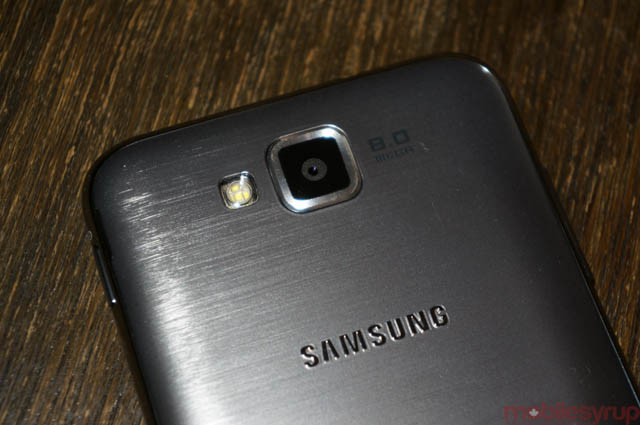
Camera
Good news for fans of mobile photography: the ATIV S takes fantastic photos. Utilizing the same 8MP rear/1.9MP front sensor combo as the Galaxy S III and Galaxy Note II, you’re in for a superlative experience. Windows Phone 8 provides a sparse but usable canvas on which to take stills and video, though the phone’s shutter isn’t quite as quick as its Android counterpart. The benefit comes from a hardware button which allows for more accurate staging, in addition to tactile feedback.
Windows Phone 8 also bridges the gap between first- and third-party camera apps with Lenses, which provide access to various esoteric capabilities straight from the camera app itself. In the case of the ATIV S, this means you can download the official CNN app and submit an iReport in two taps.


Video quality is also quite good, though the phone lacks the image stabilization of the Lumia 920. Since the Lumia received its PR1.1 update it has retaken the lead in the WP8 camera quality department — daylight shots are no longer soft — and puts the ATIV S to shame in the low-light department. The large phone benefits in this regard from being lightweight as it’s easier than the slightly-awkward Lumia to keep stable with one hand.
The phone also splits the front-facing camera win with the Windows Phone 8X. HTC implemented a 2MP wide-angle front-facing camera capable of shooting HD video, and though the ATIV S produces excellent results it does not manage to outdo the HTC for sheer versatility.
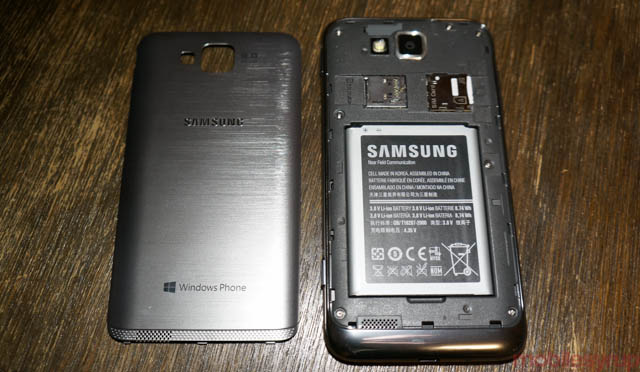
Battery Life and Network Speeds
The removable 2300mAh battery in the ATIV S is large enough that, when combined with Windows Phone 8’s excellent power management, it can last two days on a single charge. In regular use on the Rogers LTE network I was able to eke between 18 and 28 hours before hitting the red.
The ability to replace the cell with another is perhaps the biggest benefit of the ATIV S, and forgives the plastic battery cover. Enlarging the existing 11GB of free space with a 32 or 64GB microSD card — newly supported on Windows Phone 8 — is another advantage of the ATIV S over the Lumia 920 or 8X, especially if you’re into heavy media consumption.
Samsung’s device performed as expected on the Rogers LTE network. We consistently achieved between 12 and 40Mbps down and 6-20Mbps up depending on network conditions and time of day.

Conclusions
The Samsung ATIV S is a good phone. It’s an appropriate device to sum up the year; its consummate performance, build quality and design feel very much a product of 2012, whereas the Lumia 920 and Windows Phone 8X embody forward-facing designs and next-year technology. Available on Rogers, TELUS and Bell, the ATIV S isn’t quite what it should have been, but maintains Samsung’s position as a competitive and reliable smartphone maker.
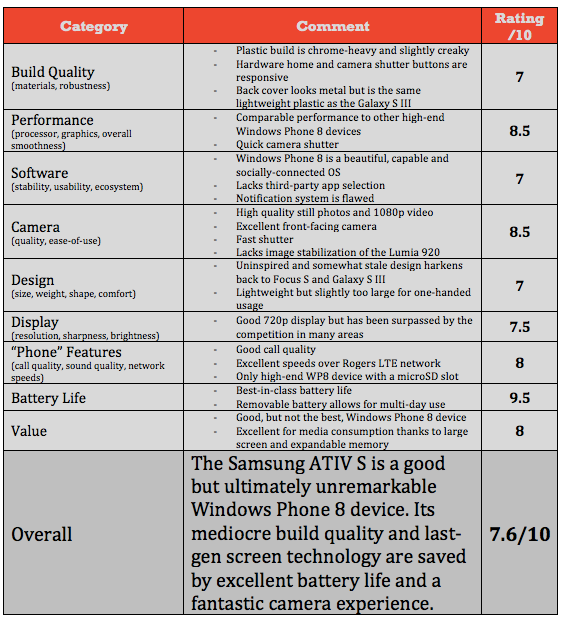
MobileSyrup may earn a commission from purchases made via our links, which helps fund the journalism we provide free on our website. These links do not influence our editorial content. Support us here.


